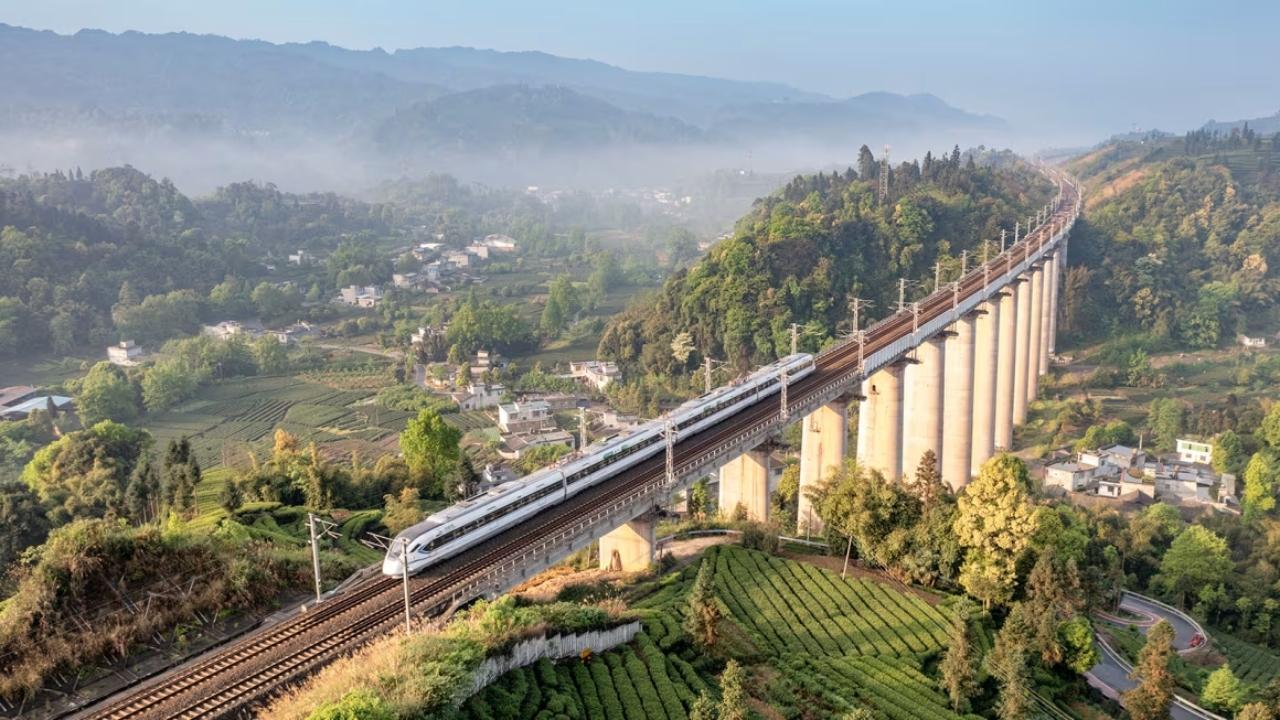
Post by : Ramanpreet Kaur
The European Commission is poised to release a sweeping high-speed rail strategy this autumn, one that's both ambitious in scale and urgent in purpose. Announced by EU Transport Commissioner Apostolos Tzitzikostas, the plan envisions a 49,400 km high-speed rail network, linking all member-state capitals and major cities, with an estimated cost of €546 billion. The goal: double high-speed rail usage by 2030, and triple it by 2050.
At the heart of this strategy lies a dual imperative—climate action and mobility enhancement. Rail is increasingly seen as a viable alternative to short-haul flights, offering a 93% reduction in CO₂ emissions on routes like Amsterdam–London when compared to air travel. Yet rail still accounts for an embarrassingly small slice—less than 10%—of cross-border EU travel.
A 2020 European Environment Agency assessment further underscores rail's environmental advantage: it's the most eco-friendly motorized passenger mode after walking and cycling. Meanwhile, other sources highlight that rail emits four to twelve times less CO₂ per passenger-kilometer than planes.
By shifting journeys to rail—particularly across hundreds of kilometers—Europe could trim emissions by millions of tons annually. A study by Rebel Group for ProRail estimates that broad modal shift could save around 8.4 million tonnes of CO₂ per year.
The network aims not only to ply more rails but also to solve deep-rooted problems. Tzitzikostas emphasises that a successful rollout must align:
Financing: A blended model involving EU support, national funds, and private investment is essential to unlock the heavy costs—estimated at €20 billion per year over three decades.
Operational Integration: Today’s fragmented network—due to varying track systems, signalling technologies, and ticketing platforms—thwarts seamless travel.
Market Openness: Encouraging new operators to enter the market could bring competition, lower prices, and improve service.
Unified Management: Harmonizing operational rules and booking systems is pivotal—much like airline booking models already do.
Without these changes, air travel—subsidized, tax-exempt, and easier to book—will continue to attract most travelers. A Greenpeace assessment of 112 European routes found rail fares are often twice as expensive as flying.
On the ground, change is underway. The launch of a direct high-speed rail link between Prague, Berlin, and Copenhagen (11-hour route) demonstrates rising demand and sets the tone for what’s to come.
Meanwhile, projects like Rail Baltica underscore Europe-wide connectivity ambitions. Covering 870 km across the Baltics, this standard-gauge line is slated to open progressively from 2028, with completion by 2030. Benefits include improved freight flow, regional economic uplift, and climate gains.
Investments are paying off elsewhere too. In France and Spain, the cooperative high-speed services of Renfe-SNCF have saved one million tonnes of CO₂ since 2013.y In Switzerland, scenic trains like the Glacier Express also demonstrate that low-emission rail can blend sustainability with experiential travel.
The success of this plan hinges on regulatory, financial, and political alignment across the EU. The Commission is exploring innovative funding tools—from green bonds to emission-based levies and public-private partnerships—to plug the gaping finance deficit.
Even as construction begins, Commissioner Tzitzikostas remains resolute:
“I’m already picturing the day when someone can have lunch in Copenhagen and arrive for dinner in Prague…”
That visionary visage captures what’s at stake—a greener, more united, and smarter Europe—powered not by fossil fuel burdens, but by the electric hum of high-speed rail.
High-speed rail Europe, EU transport strategy










Advances in Aerospace Technology and Commercial Aviation Recovery
Insights into breakthrough aerospace technologies and commercial aviation’s recovery amid 2025 chall

Defense Modernization and Strategic Spending Trends
Explore key trends in global defense modernization and strategic military spending shaping 2025 secu

Tens of Thousands Protest in Serbia on Anniversary of Deadly Roof Collapse
Tens of thousands in Novi Sad mark a year since a deadly station roof collapse that killed 16, prote

Canada PM Carney Apologizes to Trump Over Controversial Reagan Anti-Tariff Ad
Canadian PM Mark Carney apologized to President Trump over an Ontario anti-tariff ad quoting Reagan,

The ad that stirred a hornets nest, and made Canadian PM Carney say sorry to Trump
Canadian PM Mark Carney apologizes to US President Trump after a tariff-related ad causes diplomatic

Bengaluru-Mumbai Superfast Train Approved After 30-Year Wait
Railways approves new superfast train connecting Bengaluru and Mumbai, ending a 30-year demand, easi